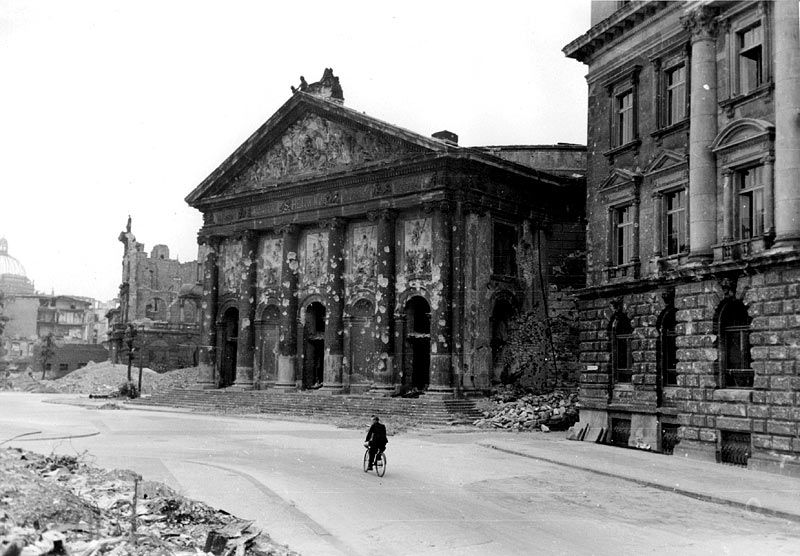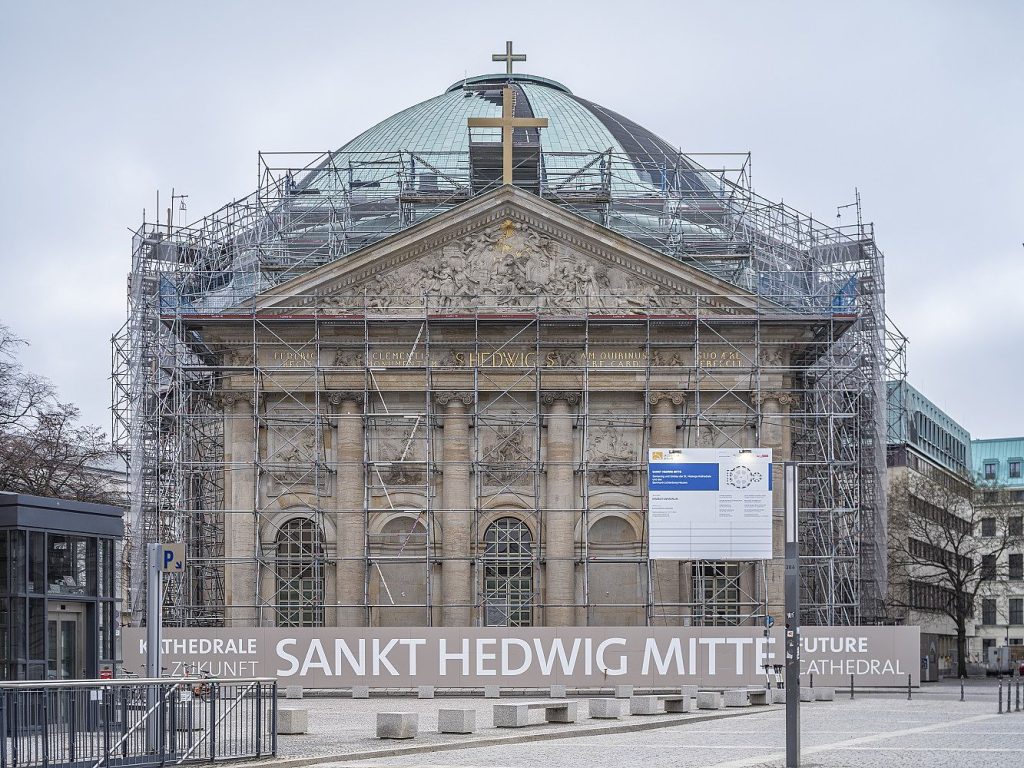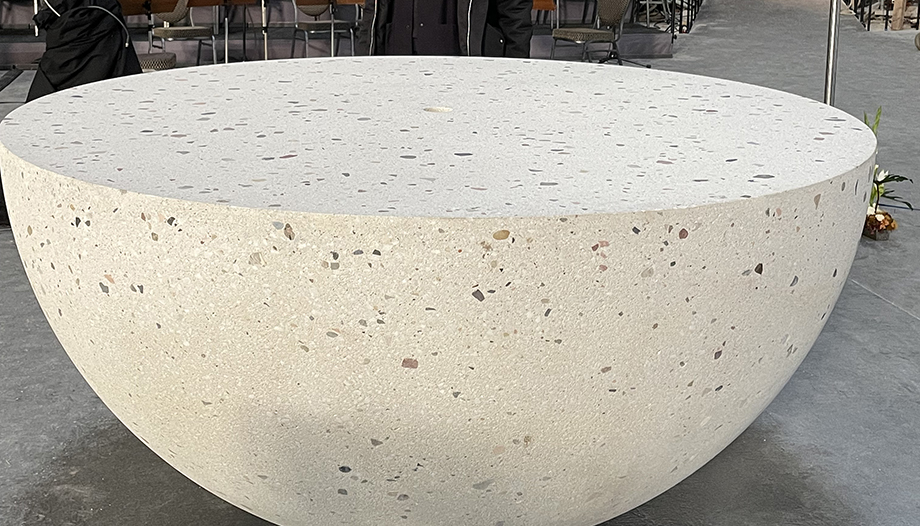On November 1, just 250 years after the first consecration of the church of St. Hedwig (St. Hedwig), the new altar of Berlin's Catholic Cathedral was consecrated. The church was closed for five years to be completely remodeled inside.
The new altar
The new altar has a hemispherical shape, which corresponds to the dome that covers the building. A special feature of this altar is that it is built with "living stones" donated by the faithful from Berlin, other parts of Germany and other countries. However, the remodeling of the cathedral has not yet been completed, so it has been closed to the public again in order to finish the work.
Leo Zogmayer, the Austrian artist responsible for the interior of the cathedral, explained at a press tour on November 1 that the altar was made using the stone casting process: "Donated stones are added to a mixture of sand, gravel and white cement. This mass is poured into a negative mold. Once the mass has hardened and the mold has been demolded, the rough casting still needs to be finished by hand to expose the stones near the surface." The altar weighs about two and a half tons, but it almost seems to float, while conveying a massive presence.
A relic of St. Hedwig of Andechs, patron saint of the church, was embedded in the mensa of the altar during the consecration. The ambo is made of the same stone as the altar; its reduced shape corresponds to the minimalist geometric hemisphere of the altar.
Archbishop Heiner Koch, Archbishop of Berlin, recalled in his homily that "Jesus is the center and measure of the life of humanity. In him we find support and orientation in the challenges of our time, the center and measure of our lives. In the sacrifice of the cross, Jesus unites us with God in time and eternity; he unites heaven and earth and gives us redemption."
On the altar his death is celebrated, not only as a memorial, but as a real presence: here the bread and wine become the body and blood of Christ by the Spirit of God; here he is truly present. "Here what happened on the Cross and in the Upper Room is made present, because He loved His own who were in the world, He loved them to perfection. That is made present here, on this altar when the priest, called by the consecration, pronounces the words of consecration in the name of Jesus, in his authority. Christ is in our midst. The altar maintains communion with heaven: the communion of God, which alone gives peace. And it also maintains communion "with us and among us".
St. Hedwig's Cathedral
Berlin's Catholic cathedral, the Sankt Hedwigs-Kathedrale (St. Hedwig's Cathedral), is located in the center of the city, forming part of the so-called Forum Fridericianuma square planned by the Prussian king Frederick II (1712-1786) at the beginning of the emblematic avenue Unter den LindenThe construction was entrusted to one of the most outstanding German architects of the 18th century, Georg Wenzeslaus von Knobelsdorff, who was also the architect of the church.
The construction of the cathedral began in 1747 and represented the first Catholic church in Berlin since the Reformation. Frederick II decided to dedicate the church to St. Hedwig in honor of the new Catholic inhabitants of Berlin who arrived after the Second Silesian War, which ended in the same year.
King Frederick II donated the land and suggested the circular shape, inspired by the Roman Pantheon. It has been claimed that initially Frederick II considered dedicating the building to "all the gods" (like the Pantheon), to be used by different religions, following his principle of tolerance. Whether this is true or not, Knobelsdorff maintained the circular shape of the Pantheon.
Construction was hampered by financial difficulties and the Seven Years' War, which delayed completion until November 1773. The dome and pediment frieze were completed in the late 19th century, and in 1886-1887, Max Hasak finished the building, covering the dome with a copper coating and crowning it with a lantern and cross. The interior was decorated in neo-baroque style. In 1927, Pope Pius XI granted the church the title of minor basilica.
With the creation of the Berlin diocese on August 13, 1930 (until then it was part of the diocese of Breslau, today's Wrocław in Poland), the church of St. Hedwig became the cathedral of the new diocese. In 1930-1932, the interior was remodeled by the Austrian architect Clemens Holzmeister.
Bernhard Lichtenberg, the brave dean
During the National Socialist period (1993-1945), the dean Bernhard Lichtenberg stood out as an opponent of the regime: after the pogrom, euphemistically called "Night of Broken Glass", which took place on the night of November 9-10, 1938, he prayed publicly for the Jews. The next day, Lichtenberg was imprisoned by the Nazi government and died on his way to the Dachau concentration camp. In 1965 Lichtenberg's remains were brought to the crypt of the cathedral. During renovation work in 2018, his relics were moved to another Berlin church dedicated to the martyrs; they will return to the cathedral crypt when the work is completed.

In World War II, the cathedral suffered severe damage during an Allied air raid on the night of March 2, 1943, which destroyed the dome and left the interior and crypt completely charred.
After the division of Berlin after World War II, the cathedral remained in East Berlin. It was restored between 1952 and 1963, by the West German architect Hans Schwippert, who reconfigured the space in an unusual way, creating a circular opening in the church leading to the crypt, where eight chapels were installed. The exterior was reconstructed following the historical model.
The restoration of the cathedral
At the beginning of the 21st century, it was decided to carry out a restoration to renovate the building. In the competition organized in 2013, the project of the Sichau & Walter studio from Fulda, in collaboration with the artist Leo Zogmayer, proposed closing the opening to the crypt, locating the descent into the crypt near the entrance and creating a large space in the upper church with the altar at its center.
This project was controversial, especially among Catholics who had suffered persecution during the communist period and had a strong attachment to the cathedral as remodeled by Hans Schwippert. After years of consultations, protests and studies, Archbishop Heiner Koch of Berlin and the cathedral chapter approved the project; work began in 2018.

On a visit to the construction site for the press in September 2022, the dean of the cathedral, Tobias Przytarski, emphasized the principle behind the "new" cathedral: in the crypt, the baptismal font occupies the center, above which - in the church - is the altar, two meters in diameter. Just above the altar, in the dome, is the skylight covered by a diaphanous glass that opens to heaven: baptism and the Eucharist lead - "hopefully," Przytarski said with a wink - to heaven. The confessionals are in the lower church.
On the exterior, the most significant change is that the new three-meter-high golden cross will be placed above the tympanum of the portico instead of the dome, which will make it more visible. In addition, the previous heavy bronze doors will be replaced by transparent glass doors, which will provide a luminous transparency and symbolize transparency. Przytarski also mentioned a particularity of the stained glass windows, which are opaque, but contain air bubbles that will show the starry sky of Berlin on the day of Jesus' birth.
After the consecration ceremony of the altar, the cathedral has been closed to the public again, and is expected to reopen before Christmas 2024, when the organ, which was dismantled at the beginning of the works, will also be installed.








